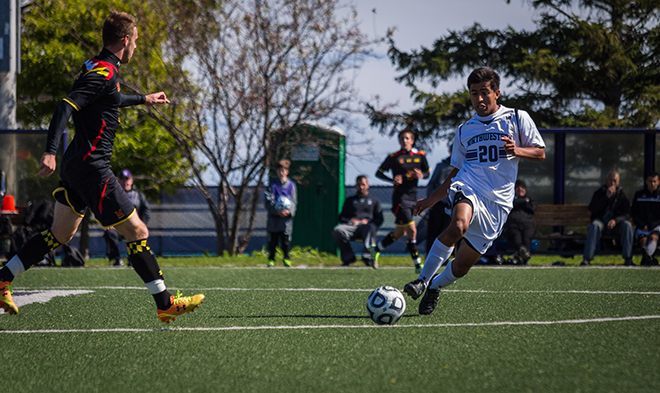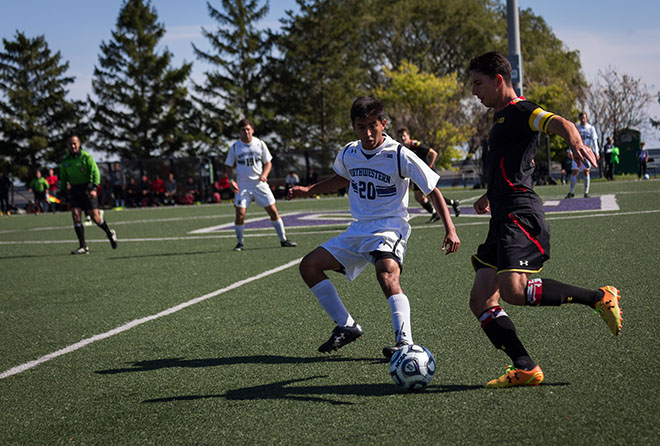Brandon Medina's freshman year was supposed to end in November. Instead, it wrapped up prematurely at the beginning of October, ten games before Northwestern's final match.
Since returning from the torn anterior cruciate ligament (ACL) he suffered one year ago, the sophomore midfielder, former Illinois Gatorade Player of the Year and unanimous selection to last year's Big Ten All-Freshman Team has lost some of his explosiveness, according to head coach Tim Lenahan. But as the quarterback and main facilitator of Northwestern's attack, Medina still makes the offense tick.
"I really hold myself responsible for the team's attack," he said after a practice at Lakeside Field. "I know if we're not getting any good looks, it's kind of my fault."
ACL tears typically happen as the result of non-contact incidents – around 75 to 80 percent of the time, according to top Chicago orthopedic surgeon Dr. Brian Cole.
Cole, who has performed knee surgery on professional athletes like Bulls guard Derrick Rose, explained that there are several reasons for this phenomenon, including fundamental anatomical differences by sex that make females more vulnerable, as well as quadriceps-to-hamstring ratio differences between athletes.
"It can also be how they jump and land in terms of knee inflexion angle and how they land on their toes versus their heels," Cole said. "The non-contact mechanism seems to be the sort of perfect storm. It's a brief hiccup in one's protective mechanisms."
Medina was no exception to the rule. Around the 20th minute of Northwestern's matchup against the Northern Illinois Huskies on Oct. 9, 2013, he was jogging down the pitch when, as he remembers, "I turned and just fell down."
At the time of Medina's injury, Northwestern was 7-3 and in the midst of tacking on another win. (The 'Cats would go on to beat the Huskies, 1-0.) But during the four following matches – all of which went into double-overtime – Northwestern scored two goals in total. The season came to an end in the first round of the NCAA Tournament with a loss to Bradley, and Northwestern finished with eight goals during Medina's ten-game absence.
Motivated to return to a squad in need of his passing touch, Medina worked hard to get back on the pitch – with a little help from his teammates.
"Our team is so tight-knit that whenever one of us goes down, we just try to get them back as quickly as possible and try to help them out in any way we can," said junior forward Joey Calistri.
Torn ACLs have been known to sideline athletes for up to a year, according to Cole, though one typically returns after roughly 6-8 months. Medina was on the lower end of the spectrum, and his recovery process also had a bit of a silver lining.
"I had a pretty good recovery. It took six months right on the dot," Medina said. "It wasn't so much physical growth as mental growth; I really toughened up. The team, the staff and athletic trainers were very helpful."
Some athletes aren't so lucky. As Cole noted, torn ACLs can create rather unpredictable recoveries.
"Everyone's different," said Cole, stressing that you can't set a specific timeline for ACL injuries. But depending on the sport, athletes tend to follow the same general pattern.
"At first, you have reduction of swelling and trying to get the early range of motion back," Cole said. "By 12 weeks, my patients are running and by four months, they're starting to do some non-competitive, non-contact sport-specific activities."
Near the end of the recovery process, Cole said he assesses his patients to make sure they're prepared to return to the sport – which means putting them through high-agility plyometrics that focus on balance and speed. The next and final step is then putting them back in competition.
Through 12 matches – one more than he appeared in last year – Medina's return has already paid dividends for a Northwestern soccer team that has lost only twice this season. When the 'Cats faced then-No. 17 (and current No. 1) Indiana on Sept. 28 this year, Medina was there to knock in the equalizer in the waning minutes of regulation. In the following match, he had an even more Medina-esque performance: three assists in a 3-2 overtime victory over Maryland.
"It was definitely a long journey back for him, but that's expected," Calistri said. "He's done a great job this season coming back and building up his fitness and just getting better game-by-game. It's obviously great for us because he's a big part of the team and he helps make our offense go."
Whether or not Medina's return has been directly responsible for Northwestern's more inspired attack this season (14 goals in 12 matches, including seven in the last five), Lenahan is quick to acknowledge that his midfielder's agility isn't quite what it used to be.
"He doesn't have a lot of the explosion that he had prior to the injury," Lenahan said. "You have to realize that maybe you don't have that quickness and you have to be a little more savvy in the way you play."
Athletes returning from ACL tears need time for their motor skills to completely recuperate, according to Cole. But can they ever recover completely?
“Absolutely," Cole said. "What's interesting is that depending on rehabilitation, an athlete can be even better because they're doing a regimen that goes beyond what they would normally do."
Medina realizes he might have lost a step, but he also doesn't need to be Lionel Messi for Northwestern to score goals. When the sophomore's passes click, so does the offense.
"I agree with coach, I'm not as fast or quick as I used to be last year," Medina said. "But I feel very confident with the ball. It'll take time, but I'll get my explosiveness back and hopefully I'll be even better than last year."
At least one Northwestern attacker has still maintained his confidence in Medina.
"He's one of the players you trust with the ball," Calistri said. "He's very technical and he knows what he's doing going forward, which is really important to have as an attacking midfielder. He just does a good job of sending through balls to our outside mids and getting the offense going."
Last year, Medina was second on the team in assists while playing in 11 of Northwestern's 21 games. But even with all the games he sat out, Medina's opponents didn't forget the three goals and five assists he recorded while on the field. Unanimously selected for the Big Ten All-Freshman Team, he also finished ninth in the conference in total assists while playing in half as many games as the majority of his competitors.
“When you have a guy like Joey who can finish whatever you put inside the box, I just have to slip some balls through,” Medina said. “I'm not a dribbler, but when I get the ball facing up the field and people are making runs, I will find them.”


